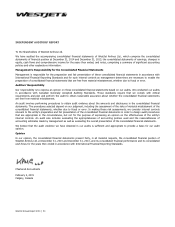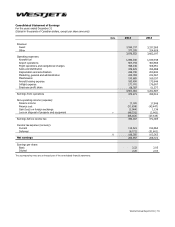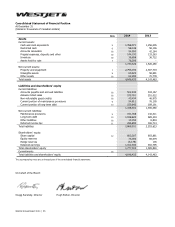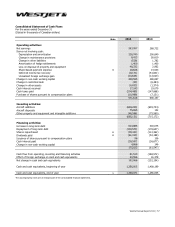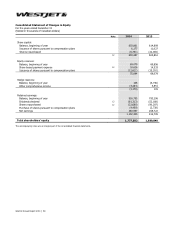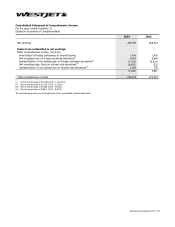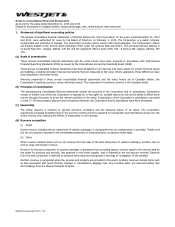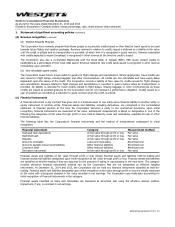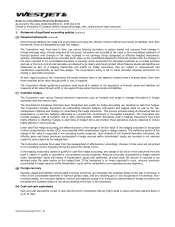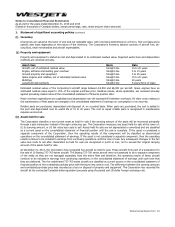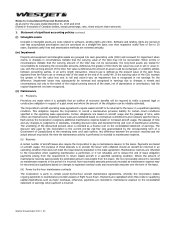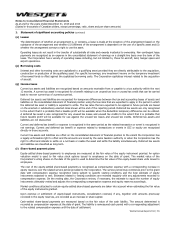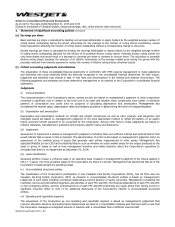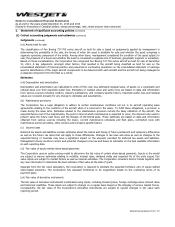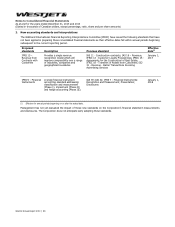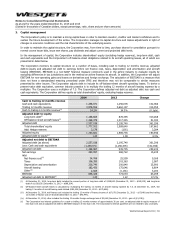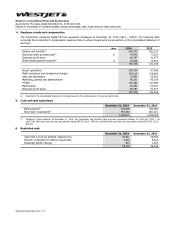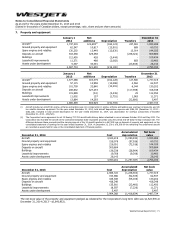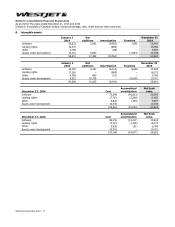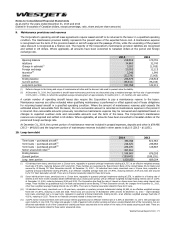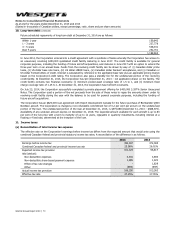Westjet 2014 Annual Report Download - page 66
Download and view the complete annual report
Please find page 66 of the 2014 Westjet annual report below. You can navigate through the pages in the report by either clicking on the pages listed below, or by using the keyword search tool below to find specific information within the annual report.
Notes to Consolidated Financial Statements
As at and for the years ended December 31, 2014 and 2013
(Stated in thousands of Canadian dollars, except percentage, ratio, share and per share amounts)
WestJet Annual Report 2014 │ 64
1. Statement of significant accounting policies (continued)
(l) Intangible assets
Included in intangible assets are costs related to software, landing rights and other. Software and landing rights are carried at
cost less accumulated amortization and are amortized on a straight-line basis over their respective useful lives of five to 20
years. Expected useful lives and amortization methods are reviewed annually.
(m) Impairment
Property and equipment and intangible assets are grouped into cash generating units (CGU) and reviewed for impairment when
events or changes in circumstances indicate that the carrying value of the CGU may not be recoverable. When events or
circumstances indicate that the carrying amount of the CGU may not be recoverable, the long-lived assets are tested for
recoverability by comparing the recoverable amounts, defined as the greater of the CGU’s fair value less cost to sell or value-in-
use, with the carrying amount of the CGU. Fair value is defined as the amount an asset could be exchanged, or a liability settled,
between consenting parties, in an arm’s length transaction. Value-in-use is defined as the present value of the cash flows
expected from the future use or eventual sale of the asset at the end of its useful life. If the carrying value of the CGU exceeds
the greater of the fair value less cost to sell and value-in-use, an impairment loss is recognized in net earnings for the
difference. Impairment losses may subsequently be reversed and recognized in earnings due to changes in events and
circumstances, but only to the extent of the original carrying amount of the asset, net of depreciation or amortization, had the
original impairment not been recognized.
(n) Maintenance
(i) Provisions
Provisions are made when it is probable that an outflow of economic benefits will be required to settle a present legal or
constructive obligation in respect of a past event and where the amount of the obligation can be reliably estimated.
The Corporation’s aircraft operating lease agreements require leased aircraft to be returned to the lessor in a specified operating
condition. This obligation requires the Corporation to record a maintenance provision liability for certain return conditions
specified in the operating lease agreements. Certain obligations are based on aircraft usage and the passage of time, while
others are fixed amounts. Expected future costs are estimated based on contractual commitments and company-specific history.
Each period, the Corporation recognizes additional maintenance expense based on increased aircraft usage, the passage of time
and any changes to judgments or estimates, including discount rates and expected timing and cost of maintenance activities.
The unwinding of the discounted present value is recorded as a finance cost on the consolidated statement of earnings. The
discount rate used by the Corporation is the current pre-tax risk-free rate approximated by the corresponding term of a
Government of Canada Bond to the remaining term until cash outflow. Any difference between the provision recorded and the
actual amount incurred at the time the maintenance activity is performed is recorded to maintenance expense.
(ii) Reserves
A certain number of aircraft leases also require the Corporation to pay a maintenance reserve to the lessor. Payments are based
on aircraft usage. The purpose of these deposits is to provide the lessor with collateral should an aircraft be returned in an
operating condition that does not meet the requirements stipulated in the lease agreement. Maintenance reserves are refunded
to the Corporation when qualifying maintenance is performed, or if not refunded, act to reduce the end of lease obligation
payments arising from the requirement to return leased aircraft in a specified operating condition. Where the amount of
maintenance reserves paid exceeds the estimated amount recoverable from the lessor, the non-recoverable amount is recorded
as maintenance expense in the period it is incurred. Non-recoverable amounts previously recorded as maintenance expense may
be recovered and capitalized based on changes to expected overhaul costs and recoverable amounts over the term of the lease.
(iii) Power-by-the-hour maintenance contracts
The Corporation is party to certain power-by-the-hour aircraft maintenance agreements, whereby the Corporation makes
ongoing payments to maintenance providers based on flight hours flown. Payments are capitalized when they relate to qualifying
capital expenditures such as major overhauls, otherwise, payments are recorded to maintenance expense on the consolidated
statement of earnings when payment is incurred.


